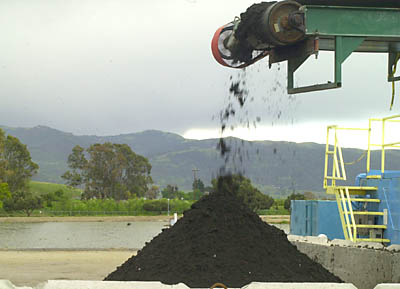
After considering a natural, island-based sewer treatment concept for the city’s industrial pond back in February, Hollister council members suddenly shifted gears Monday and approved a more traditional process to remove sludge at the odor-plagued location.
Council members approved spending $2.13 million on sludge removal at the two wastewater plants, domestic and industrial. City officials in February held a special meeting to hear from Mokelumne Hill-based Floating Islands West, LLC. The company’s process uses plant-based floating islands employing organic bacteria to consume organic materials. Its proposal contended the process would cost less while saving energy compared with the aerators and more traditional sludge removal.
Mayor Ignacio Velazquez, a proponent of the idea, argued at the time the industrial pond costs about $800,000 annually to operate including energy costs, while the wetland idea would cost $15,000 annually while gradually eliminating sludge. The San Benito Foods tomato cannery that uses the pond would pay for most of the upgrades, according to officials. San Benito Foods pumps 2 million to 2.5 million gallons of water into the pond during its canning season starting in July.
Council members left the meeting advising engineering staff officials to return with more answers on the available options. City leaders were hoping to get a solution in place before the summer. Last summer, due to the built-up sludge across the entire industrial pond, residents had to contend with frequent odor issues from the industrial pond located at the end of South Street on the west side.
On Monday, engineering official David Rubcic returned with the proposal to use traditional sludge removal. Officials at the meeting vaguely referenced a study recently commissioned by San Benito Foods that reportedly debunked the validity of the floating islands concept, but Hollister officials didn’t discuss details from it further.
Instead, they approved about $1 million in traditional sludge removal from each of the two sewer ponds. Council members voted 4-1 on the matter, with Councilman Ray Friend dissenting.
The city will contract with its private wastewater pond operator, Veolia Environmental Services, whose representative had objected to the floating islands concept at the February meeting.
Although Jim Heitzman from Veolia in February claimed the company could remove all of the industrial pond sludge for $1 million, the proposal approved Monday includes a projection to remove half of the sludge. That amounts to about 20 years of buildup, while Mayor Ignacio Velazquez indicated Monday he would still like to have the Floating Islands West company come in, after the initial sludge is removed, to see what it can do as well.
“As we pull out 50 percent, maybe we can look at this other system,” a frustrated Velazquez said Monday.
That means the city might be paying two contractors to address the sludge issue, but Velazquez on Tuesday said he doesn’t want to remove just half of the mess and leave the problem for a future council.
“Yes and no,” he said of paying multiple contractors, “because there’s still sludge in there.”









